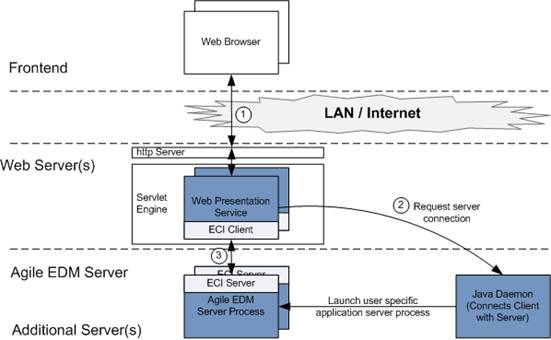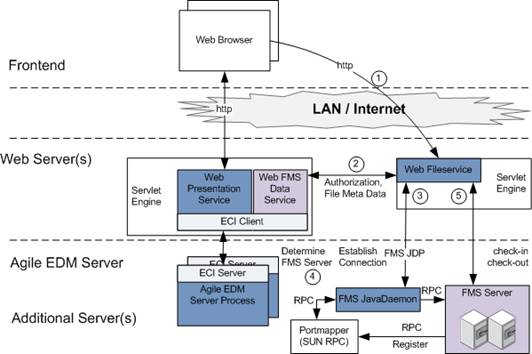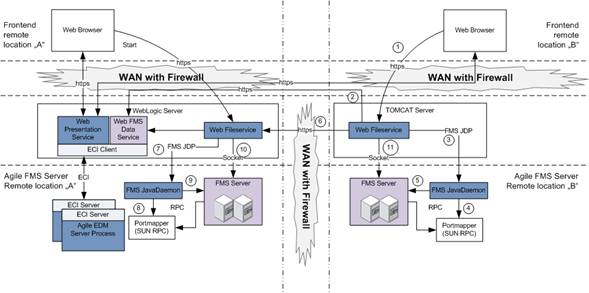| Oracle Agile Engineering Data Management Architecture Guide Release e6.2.0.0 E52551-02 |
|
 Previous |
 Next |
| Oracle Agile Engineering Data Management Architecture Guide Release e6.2.0.0 E52551-02 |
|
 Previous |
 Next |
The lines of communication when starting the Web Client, respectively when accessing the corresponding URL in a web browser, are depicted in the following graphic:

The following steps are executed when you launch the Web Client:
The web browser sends a request to the Web Presentation Service that is hosted by the servlet engine.
|
Note: t is possible to configure the web browser in a way that it bypasses the HTTP server and communicates directly with the servlet engine. This configuration may be configured if the web browser is not used for other (HTTP) services but for the Agile e6 Web Client. |
The Web Presentation Service connects the Java Daemon, requesting to launch a user specific Application Server Process and to return the connection information for this process.
The Web Presentation Service connects to the given Application Server Process via ECI.
The Web Presentation Service will process requests from the web browser by translating these into ECI calls to the Application Server Process. The Web Presentation Service is also responsible for the rendering of lists and forms into DHTML (dynamic HTML - HTML enriched with JavaScript). The JavaScript in the HTML pages realizes consistency checks and interactive controls within the Web Client.
The following table contains the details about the relevant lines of communication:
| Line of Communication | Type | Port or Range of Ports |
|---|---|---|
| (1) | HTTP (or HTTPS) | Port 8088 by default (can be configured during installation) |
| (2) | Application specific protocol based on Sockets | Port 16077 by default (can be configured during installation) |
| (3) | Application specific protocol based on Sockets | One unprivileged port per Application Server Process from range as configured for Java Daemon (5000 to 5999 by default) |
The communication between the Web Client, the Agile e6 application server process, the Web Services and the FMS Server is depicted in the following figure:

The following steps are executed when you perform a check-in or a check-out operation in the Web Client:
The web browser sends a request to the Web Presentation Service. This request is recognized as a file check-in or check-out operation and as a result, the web browser is re-directed to the Web Fileservice. The address of the Web Fileservice is taken from the configuration of the corresponding vault in the Agile e6 database.
For a check-out operation, the web browser sends the corresponding request parameter to the Web File Server.
For a check-in operation, the web browser sends the corresponding file to the Web File Server.
|
Note: The Web Presentation Service and the Web Fileservice can be hosted by the same servlet engine. For performance reasons it is recommended to use two separate servlet engines. |
The web browser can be configured to bypass the HTTP server and communicates directly with the servlet engine. This configuration may be configured if the web browser is not used for other (HTTP) services but the Agile e6 Web Client.
To avoid a misuse of the Web Fileservice, the re-directed request contains an authorization ticket and the address of the Web FMS Data Service. This service is hosted by the same servlet engine as the Web Presentation Service and they share a single ECI connection to the Application Server Process. The Web Fileservice provides the authorization ticket, and in return, receives required file metadata.
With the RPC-number of the FMS Server, the Web Fileservice connects to the Portmapper to determine the port of the corresponding FMS Server.
Now the Web Fileservice can request the FMS Server to initiate an individual thread and return the connection parameter.
The file data are transmitted between the Web Fileservice and the FMS Server thread. The Web Fileservice itself returns the call to the web browser.
Files are not temporarily stored on the Web Server, but transferred directly between the web browser and the FMS Server. This avoids possible security issues - files that resided temporarily on the web server are accessible by all users - and increases performance especially in the case of large files, because only a minimum of file write/read operations are performed.
The following table contains the details about the relevant lines of communication:
| Line of Communication | Type | Port or Range of Ports |
|---|---|---|
| (1) | HTTP (or HTTPS) | Port 8088 by default (can be configured during installation) |
| (2) | HTTP (or HTTPS) | Port 8088 by default (can be configured during installation) |
| (3) | RPC | Port 111 (used by Sun RPC) |
| (4) | RPC | One unprivileged port for each file FMS Server (typically only one), assigned by Portmapper - see (3) |
| (5) | Application specific protocol based on Sockets | One port for each concurrent file upload or download in range from 52517 to 53516. |

The communication between the Web Client, the Agile e6 application server process, the Web Services, and the FMS Server is depicted in the following figure:
The following steps are executed when you perform a file replication operation in the Web Client:
The Web Client calls the Web Fileservices to execute a file replication operation.
The Web Fileservice uses the URL information passed with the call to request the access information from the Web FMS Data Service.
With the gained access information, the Web Fileservice calls the FMS Java Daemon to get the access port of the local FMS Server.
The FMS Java Daemon requests the RPC connection information of the FMS Server from the Portmapper.
The FMS Java Daemon retrieves the FMS Server access port and sends it back to the Web Fileservice.
The Web Fileservice calls the remote Web Fileservice to request the file which should be replicated. This call is a POST request which contains the access information for the remote FMS Server.
The Web Fileservice uses the FMS Java Daemon to get the FMS Server access port.
The FMS Java Daemon requests the RPC connection information of the FMS Server from the Portmapper.
The FMS Java Daemon retrieves the FMS Server access port and sends it back to the Web Fileservice.
The Web Fileservice requests the file to replicate from the FMS Server and sends it back to the remote Web Fileservice.
The Web Fileservice sends the file to the local FMS Server.